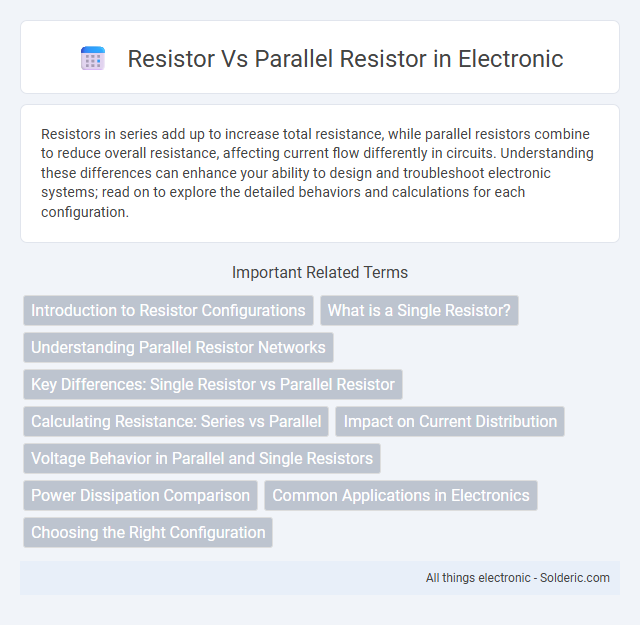Resistors in series add up to increase total resistance, while parallel resistors combine to reduce overall resistance, affecting current flow differently in circuits. Understanding these differences can enhance your ability to design and troubleshoot electronic systems; read on to explore the detailed behaviors and calculations for each configuration.
Comparison Table
| Feature | Resistor (Single) | Parallel Resistors |
|---|---|---|
| Definition | One resistor limiting current. | Two or more resistors connected in parallel. |
| Total Resistance (Rtotal) | Rtotal = R | 1/Rtotal = 1/R1 + 1/R2 + ... + 1/Rn |
| Current | Current depends on single resistor value. | Total current is sum of branch currents. |
| Voltage | Voltage drop across resistor. | Voltage across resistors is the same. |
| Power Dissipation | P = I2 x R | Sum of power dissipated in each resistor. |
| Usage | Simple current control. | Adjust resistance and increase reliability. |
Introduction to Resistor Configurations
Resistor configurations determine how resistors are connected in a circuit, significantly affecting the overall resistance and current flow. In a single resistor setup, the resistance is fixed, while parallel resistor configurations reduce the total resistance by providing multiple current paths, calculated using the formula 1/R_total = 1/R1 + 1/R2 + .... Your understanding of these configurations is essential for designing circuits with desired electrical characteristics and optimizing performance.
What is a Single Resistor?
A single resistor is an electrical component designed to limit or regulate the flow of electric current by providing a specific resistance value, measured in ohms (O). When used in a circuit, a single resistor controls voltage and current, protecting components and ensuring proper operation. Understanding how your single resistor functions is essential before exploring more complex configurations like parallel resistors.
Understanding Parallel Resistor Networks
Parallel resistor networks reduce overall resistance by allowing current to flow through multiple pathways simultaneously, making them essential for controlling voltage and current in complex circuits. The total resistance in a parallel configuration is always less than the smallest individual resistor, calculated using the formula 1/R_total = 1/R1 + 1/R2 + ... + 1/Rn. Understanding how these networks affect your circuit's behavior helps optimize performance and ensures accurate resistance values in electronic designs.
Key Differences: Single Resistor vs Parallel Resistor
A single resistor provides a specific resistance value determined by its material and dimensions, affecting current flow and voltage drop in a circuit. Parallel resistors combine multiple resistors, delivering an overall resistance lower than the smallest individual resistor, which helps distribute current across multiple paths. Understanding the difference between your single resistor and parallel resistor setups is crucial for controlling circuit behavior and optimizing performance.
Calculating Resistance: Series vs Parallel
Calculating resistance in series involves summing the resistance values of each resistor, resulting in a total resistance equal to the sum of all individual resistors (R_total = R1 + R2 + ... + Rn). In contrast, parallel resistor calculation requires using the reciprocal formula, where the total resistance is the inverse of the sum of the reciprocals of each resistor (1/R_total = 1/R1 + 1/R2 + ... + 1/Rn). Series circuits increase overall resistance, while parallel circuits reduce total resistance, impacting current flow and circuit design.
Impact on Current Distribution
Resistors in parallel create multiple pathways for current, reducing overall resistance and increasing total current compared to a single resistor. The current distribution in parallel resistors inversely depends on their resistance values, with lower resistance branches carrying higher currents. This behavior enhances circuit efficiency by evenly distributing electrical load and minimizing voltage drop across each resistor.
Voltage Behavior in Parallel and Single Resistors
In a single resistor circuit, the voltage across the resistor equals the total voltage supplied by the source, following Ohm's law (V = IR). In contrast, resistors connected in parallel experience the same voltage across each resistor despite differing currents, enabling voltage uniformity across multiple components. This voltage behavior in parallel resistors allows for current division while maintaining consistent voltage, essential for designing efficient electrical circuits.
Power Dissipation Comparison
Power dissipation in a single resistor follows the formula P = I2R, where all current flows through one component, resulting in higher heat generation. In contrast, parallel resistors divide the total current among multiple branches, reducing the current and consequently the power dissipated by each resistor. This distribution lowers overall thermal stress and enhances circuit reliability compared to a single resistor handling equivalent total resistance.
Common Applications in Electronics
Resistors are commonly used in electronics for limiting current, dividing voltage, and protecting components by dissipating power as heat. Parallel resistors are frequently applied to achieve a specific resistance value not available as a single resistor and to increase the overall power rating by sharing the load among multiple resistors. Your circuits benefit from parallel resistor configurations when precise resistance and improved heat management are required in applications like LED arrays and sensor signal conditioning.
Choosing the Right Configuration
Choosing the right resistor configuration depends on your circuit's voltage and current requirements. In a parallel resistor setup, the overall resistance decreases, allowing more current to flow without increasing voltage, ideal for lowering resistance while maintaining consistent voltage. Your design benefits from optimal power distribution and improved reliability by selecting series for higher resistance or parallel for reducing resistance and balancing current load.
resistor vs parallel resistor Infographic

 solderic.com
solderic.com